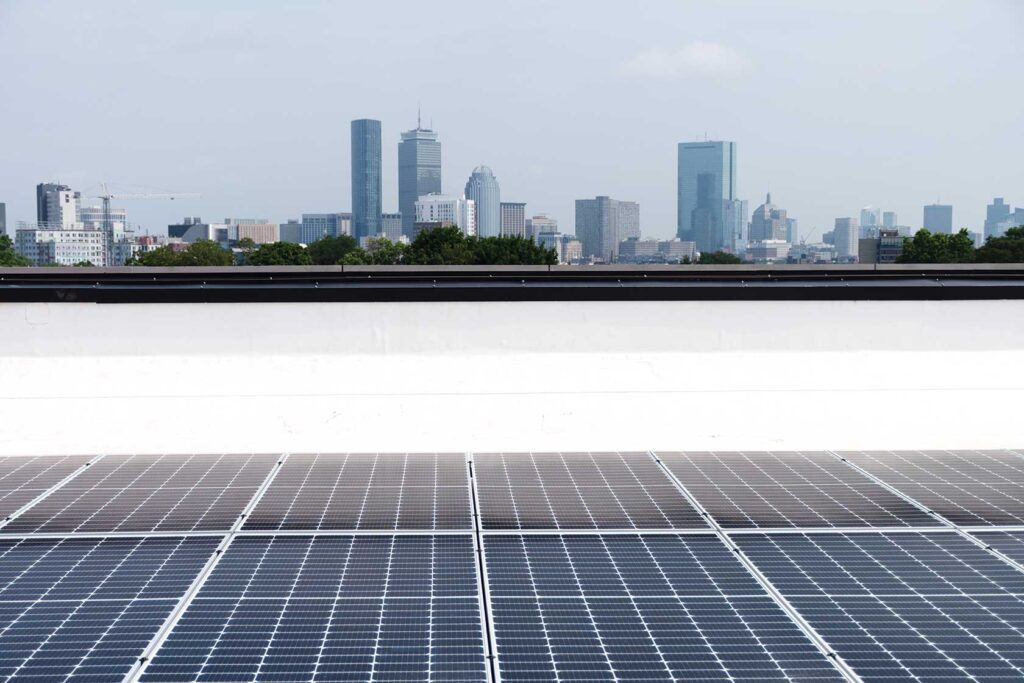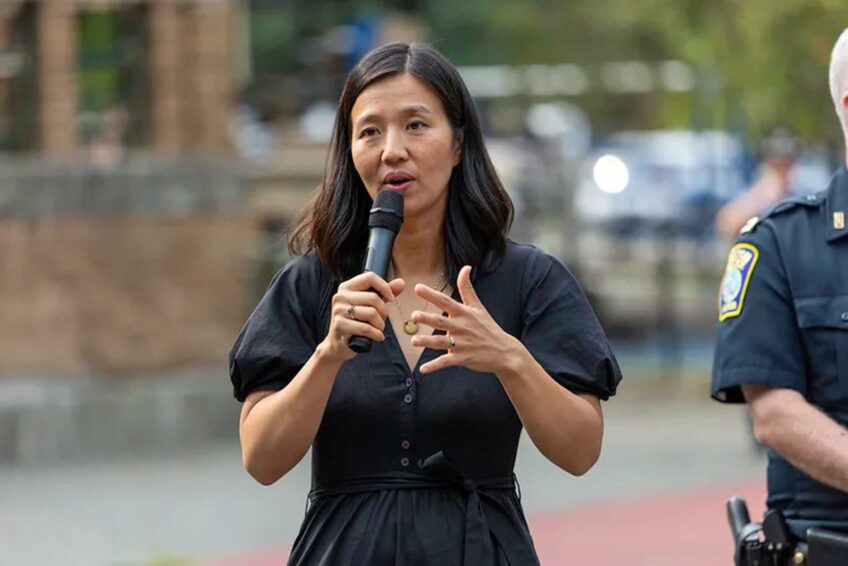
A 62-page draft of the city of Boston’s 2030 Climate Action Plan, released this month, is the first official proposal from the city on the framework that will govern the city’s climate and environmental efforts for the next five years.
It’s not the first climate action plan the city has created — municipal leaders have been conducting this process approximately every five years since 2007 — but officials said that, in many ways, this new plan is intended to be different.
This plan includes a bigger balance of emissions reductions with mitigation efforts.
When it comes to community engagement, the city is taking a different tact, letting public voices into the process earlier in the process.
The final climate action plan, which is set to be released in Spring 2026 and will guide municipal action through the end of the decade, will focus more on getting bigger climate action going, and faster.
Already, the city has made a lot of progress around high-level goal setting and analyses, said Oliver Sellers-Garcia, Boston’s environment commissioner and Green New Deal chief. This plan will mark a shift.

Oliver Sellers-Garci (right), city of Boston environment
commissioner, speaks at a press
conference May 7 about climate-focused
retrofit projects. In early August, Sellers-
Garcia and the city of Boston released a
draft of its 2030 climate action plan, a
five-year plan aimed at implementing climate
mitigation and emissions reduction
plans across Boston. PHOTO: AVERY BLEICHFELD
“It’s a pretty big pivot into implementation and near-term implementation,” Sellers-Garcia said. “This plan is really all about things that we’re going to get done from 2026 to 2030.”
A wide range of focuses
The plan divides its attention by emissions source or mitigation focus, breaking up efforts between areas like emissions from buildings, transportation and the energy grid from mitigation targets like combating heat and flooding. It also includes other climate focuses such as food access and reuse of building materials, access to open space and green workforce development.
Each area includes targets around expanding solutions that the city is already pursuing, new options it is proposing to launch and those that it intends to explore and evaluate over the next five years.
For example, when it comes to reducing emissions from buildings across the city, the draft includes efforts to grow and scale the city’s implementation of BERDO, the Building Emissions Reduction and Disclosure Ordinance, which requires larger buildings in the city to report and reduce emissions until they ultimately reach net-zero. The ordinance was passed in 2021, but this year marked the first that building owners actually have emissions standards to meet.
For smaller buildings the city proposes building on existing pilot programs to encourage steps like replacing gas stoves with electric or induction ones. New efforts include convening a restaurant decarbonization task force to address a sector that offers particular challenges around replacing appliances and retrofitting.
In the city’s plans around energy use and emissions, the city proposes continuing and expanding its community choice electricity program, while launching new efforts like a joint procurement plan to bring more renewable energy to large buildings, or exploring the role of battery storage systems, which are included in the city’s energy plan to support the electrical grid.
When it comes to resilience efforts, such as for addressing urban heat, the city outlines continued plans like expanding its cooling resources and infrastructure, while also developing heat protection interventions for workers and exploring new solutions for public cooling in a wider variety of places that are not well served by current proposals like tree planting and green-roof bus shelters.
Among the resilience efforts meant to prepare the city to face the impacts of climate change, the draft proposes addressing them through a combination of targeted capital investments, improved data systems, updated design standards and expanded partnerships.
Through the work outlined in the plan, the city’s approach to those priorities will be rooted in a “climate justice framework,” which includes priorities like improving health and quality of life for residents across the city, sharing benefits and burdens equitably and partaking in climate action in partnership with communities.
Christina Schlegel, executive director of the Global Center for Climate Justice, said she’s excited to see the city be so forthright with a climate justice framework.
It’s a model that officials said builds on existing concepts of environmental justice communities — officially designated by how much of the area has a low household income, is comprised of minority populations, or has residents with more limited English usage — while climate justice looks more forward toward future impacts from climate change.
“I think one of the key distinctions with climate justice is about recognizing that the harms of climate — the forward-looking, projected harms of climate — are really going to be borne unevenly,” Sellers-Garcia said. “That really, in a way that is more complex than environmental justice, brings together a lot of different factors that have to do with social and economic interactions with the environment.”
But he said it also means making sure that the potential benefits of climate solutions are also distributed equally.
That effort, Schlegel said, requires intentionality, something she said this draft plan starts to work toward.
“That has to be planned, you know, that has to be invested in if we’re talking about the positive impacts,” Schlegel said.
Through it all, it means bringing the communities that have long borne the brunt of environmental injustices — and that are likely primed to experience the worst impacts from climate change — into the solutions.
Part of that work is showing residents that climate actions can also be beneficial generally, said Hessann Farooqi, executive director of the Boston Climate Action Network. He called it “the most important thing we can do to build a broad coalition of residents to actually make these programs a reality in the next several years and in the next several decades.”
“Not everyone is thinking about climate change every day — most people aren’t,” Farooqi said. “If you’re struggling to pay your energy bills, you’re not thinking about where that energy comes from.”
For example, he pointed to city efforts around fare-free buses. The city has run 23, 28, or 29 without charging riders since 2021, which has increased ridership and decreased emissions from personal vehicles, while bringing other benefits like potentially saving money for riders and increasing the speed of buses.
The draft plan describes the city’s intention to find new funding sources to keep the program going and to expand it to other routes across the city.
Meeting the moment
The timing of the plan is significant, coming as climate change continues to worsen, federal support wanes and the city stares down pending deadlines in its mitigation goals, like a 2030 benchmark to reduce citywide emissions by 50% and municipal emissions by 60%.
“We’re in a moment that’s very different from where we were in 2019, the last time we had a Climate Action Plan — for better and for worse,” Farooqi said.
When it comes to a landscape of shifting federal priorities with an abrupt pull-back on climate supports from the Trump administration, the timing of the plan means considering where funding for the city’s many efforts will come from, if not the federal government.
The city has not been a stranger to seeking or receiving federal funds for its projects in the past. For example, the fare-free bus pilot operated by the city has been run using $4.2 million annually in funding through the pandemic-era American Rescue Plan Act. Or, in 2023, the city received a $11.4 million from the U.S. Forest Service to support its urban tree canopy efforts.
In the draft, the city acknowledges the landscape of “uncertain federal support” and proposes alternatives it plans to pursue, including to continue to explore public-private partnerships, to explore climate accelerators and long-term funding options and to create a city climate budget to better manage climate-related spending and investments.
Seeking community engagement
The plan has an extended review process; the document is a preliminary draft that precedes a full draft later this fall.
Throughout the new draft, survey questions prompt readers to think about and share how they expect parts of the plan will impact them and their communities. And throughout the rest of the summer, the city plans tohost meetings and engagements out across Boston’s neighborhoods.
Sellers-Garcia said that in previous climate action planning processes, the city has waited until the official public comment process to release a draft plan. This process is a shift from that, he said.
“We’re adding an additional step into the process that is, ‘Hey, take a look at what we have. Let’s all figure out how we would do it,’ and based off of how we will do it, we then decide what ends up going into the final plan,” he said. “So many of these plans have really shot for the moon before everyone gets a chance to look at it together.”
It’s intentional that this draft is not the complete plan, instead outlining the broader agenda, while leaving specific steps for further development based on input.
Over the next several months, as the city puts together its official draft, Sellers-Garcia said that they plan to try to engage with community members in a host of ways, through local meetings but also through surveys.
“We’re really trying to do it in a way that fits into everybody’s time,” he said.
The current plan is relatively limited, with the broad strokes of the city’s approach for the next five years. Elizabeth Jameson, Boston’s director of climate policy and planning, said the official full draft that will be released this fall should include more metrics and accountability defined. The final version, to be released next year, will include more specific road maps that outline how the city plans to reach its implementation goals.
That timeline gives an opportunity to bring more individuals and — too Farooqi, perhaps more importantly — organizations and institutions to support the work.
“When we take this time, we can also make sure that’s done in a way that’s transparent and equitable, so that big institutions and small community-based organizations can all be at a level playing field to make sure that we can get a wide array of partners to help implement this,” he said.
Bringing a wide collection of stakeholders into the work is a priority for the city, said Katherine Diaz, director of climate action innovation and analytics. The city, she said, is looking to serve as a leader in climate work, but to get buy-in from community organizations and larger partners.
“It’s very much an all of government, all of city, approach to our different strategies in the Climate Action Plan,” she said.







Leave a Reply
You must be logged in to post a comment.